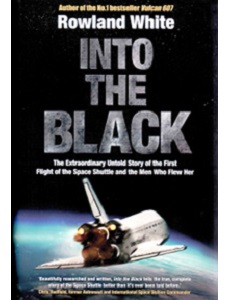Thirty-five years after the first launch of the Space Shuttle in April 1981, it must be hard to think of a new hook for a book on this unique launch vehicle and orbiter system. It’s all been said, hasn’t it? The history, the technology, the people, the ‘disasters’…so many books have been written they could fill a Shuttle payload bay!
The cover and title suggest the double meaning that forms the core of the book: it’s partly about a venture into the blackness of space and the unknown, but also into the black world of the Pentagon and the National Reconnaissance Office (NRO). The pitch, or hype, here involves the issue of thermal tile delamination and the concern that this first Shuttle would burn up on re-entry. ‘To save Columbia’, states the book’s publicity, NASA had to turn to the NRO, ‘a spy agency hidden deep inside the Pentagon whose very existence was classified.’
Although it has four main parts with titles, the text is divided into 67 unnamed chapters, so there are very few clues to the story within - parallels with Pentagon documents perhaps? The style is engaging in the sense of that American penchant for ‘historical journalism’: one chapter begins ‘Joe Henry Engle loved airplanes. Really loved airplanes’; another, ‘It wasn’t the kind of request you often heard in the Astronaut Office’ – you get the idea.
This makes the book a fairly easy read – and that is certainly not unimportant – but it’s difficult to ignore the ‘black world’ hype. The big build-up about a spy agency saving Columbia from incineration is separated from the story itself by hundreds of pages of valid and interesting stuff on the personalities and the technology; but the conclusion is a damp squib of a failure to provide any useful images of the thermal tiles in orbit. Not that the NRO could do anything to save the Shuttle and its astronauts anyway - short of launching a previously unknown spacecraft from Area 51. This whole premise may increase sales but it devalues what is otherwise an excellent example of accessible writing on a technical subject.
Mark Williamson











